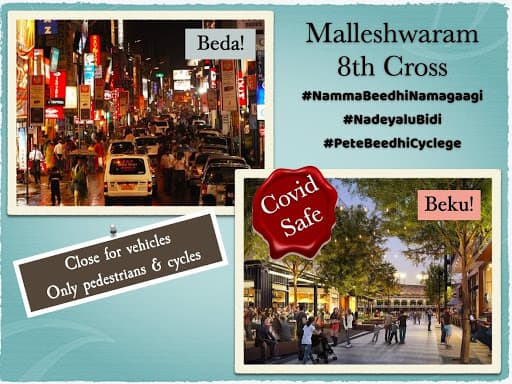As COVID-19 cases are steeply rising in Bengaluru, some citizen groups are demanding pedestrian- and cycling-friendly streets, that would help ensure social distancing in public spaces. For a start, they have sent a proposal to the state government and BBMP, specifically asking for three market streets – Commercial Street, Gandhi Bazaar and Malleswaram 8th Cross – to be closed to vehicles and be made pedestrian/cycling-friendly.
The proposal was sent by the NGO Evangelical Social Action Forum (ESAF), and endorsed by groups like Citizens for Bengaluru (CfB), Malleshwaram Swabhimana Initiative, Bangalore Apartments’ Federation, CIVIC, Jhatkaa.org, Institute for Transportation and Development Policy (ITDP), and individuals like Dr Ashish Verma and Sudeept Maiti. These groups and individuals, numbering over 40, have also started an online petition on Jhatkaa.org.

The proposal was submitted to V Manjula, Commissioner of DULT (Directorate of Urban Land Transport), BBMP Commissioner B H Anil Kumar, and Rakesh Singh, Additional Chief Secretary of the Urban Development Department.
This proposal is based a June 10 advisory by the Centre’s MoHUA (Ministry of Housing and Urban Affairs), which had called for at least three market places to be pedestrianised and made vehicle-free in cities that have population of over a million. The advisory had said, “To make market areas COVID-19 safe and people-friendly, the need of the hour is for Indian cities to consider pedestrianising them.”
As per the advisory, the three streets were supposed to be selected by June 30, but this has not been done yet. After selecting the streets, the plan for implementation is to be formalised by September end, short-term measures taken in October, and any change to be made by November.
MoHUA's key suggestions on pedestrianising market places Selection of Market Location: Million-plus cities may select at least three market places and notify them for pedestrianisation by 30 June. Holistic Planning of the Area: The planning for pedestrian-friendly market space may be done in consultation with stakeholders. This requires a proper survey of the space currently used by various stakeholders. Preparing a movement/direction plan: There should be designated walking paths where visitors can follow social distancing. Plans could be made keeping trees and other greens intact, adding tree canopy to improve walkability, with clear spaces demarcated for vending, waste collection and access to toilet facilities. Two phase implementation: Once the plan is firmed up, cities may start implementation in two phases – short-term and long-term. 1) Short-term recommendations include interventions that are quick, temporary, easy to install, and ensure safety of commuters. These include barricades, road closure for vehicles, etc. 2) Long-term permanent structures for promoting pedestrianisation can be developed after temporary short-term measures are found working.
Sonal Kulkarni, a Senior Transport Planner at DULT, says, “We have sent letters to BBMP for consideration, and are hoping for a response soon. However, owing to COVID-related activities, this may take some time.”
She says that the three streets had already been proposed for pedestrianisation in the CTTP (Comprehensive Traffic and Transportation Plan for Bengaluru) 2012, and again in the CMP (Comprehensive Mobility Plan) prepared by DULT in 2019. “DULT had completed the designs and public consultations for the Gandhi Bazaar project just before COVID crisis, and the BBMP Commissioner was happy to take it up for implementation. Commercial Street upgradation is part of the Smart Cities Mission, and we have written to both BBMP and the Bengaluru Smart City Ltd to make it a pedestrian-only project as proposed in the CMP,” says Sonal.
DULT has not yet made design plans for Malleswaram 8th Cross, and hence has requested WRI (World Resources Institute, a non-profit research organisation) to come up with some tactical urbanism (low-cost, temporary changes) until proper designs for pedestrianisation can be made, says Sonal.
Since COVID, cities across the globe have made several streets vehicle-free and opened these up to pedestrians and cyclists, so as to prevent crowding. And even before COVID, studies and experts have pointed out that Bengaluru’s concerns of pollution, traffic, and sustainability can be resolved through better pedestrianisation.
Demand for pedestrianisation in every ward
Manju George of ESAF says, “When the online petition went live, several citizens came forward and expressed their want for pedestrianisation in Bellandur, Whitfield and other areas. Proposing new streets would mean working on new projects that’ll take longer. But the MoHUA project is for short-term implementation; if stakeholders respond positively, it can serve as a point of reference for designs in the future.”
A tweetathon by the campaigners on July 1, had got tremendous response as well. The tweetathon with the hashtags #CovidSafePeteBeedhi and #CovidSafeMarketStreets trended #1 on Twitter in Bengaluru on the day.
Tara Krishnaswamy of CfB says the campaign would continue. She says, “Citizens, along with their ward committees, should identify market streets in their wards for pedestrianisation and closure of vehicular movement. The proposed three streets will be great pilots, and as the MoHUA advisory states, will keep the city safer from COVID.”
However, Sonal says that convincing shops on market streets about pedestrianisation has been a challenge. “Establishments are worried that if cars are denied access to market areas, their business will suffer losses. But pedestrianisation helps businesses, because when people walk, they tend to visit more shops than when they are in a car.”
Also read
► Urban Affairs ministry cites Chennai-Pune examples to push for pedestrian-only markets
► How public spaces can be redesigned to make ‘unlocking’ safe in Bengaluru